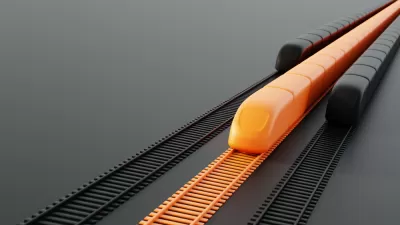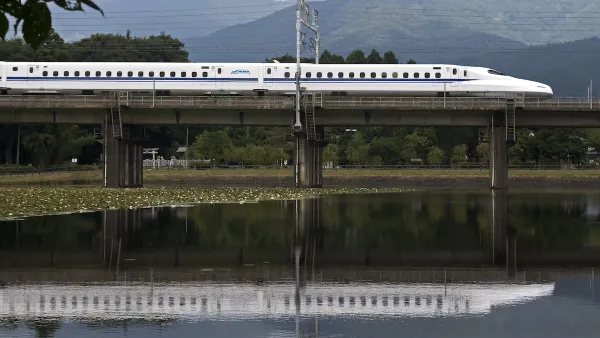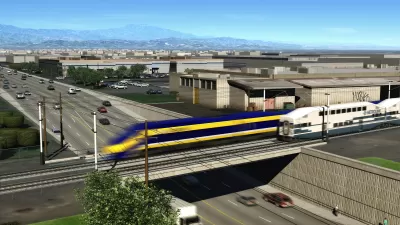Slow progress and a bloated budget have plagued the High-Speed Rail project linking San Francisco to Los Angeles, exposing deeper issues with American transit projects.

Believe it or not, it’s been 58 years since the Shinkansen, the world’s first bullet train, first debuted in Japan in 1964. During a five-year construction period, the project completed 320 miles (ca. 515 km) of track, eventually achieving the three-hour service it had projected.
Over that same time period, the United States has built zero miles of high-speed rail (save a few short stretches of the Acela line in the Northeast United States that achieve speeds of about 150 mph). Meanwhile, the fact that the technology still hasn’t come to the United States has deflated a generation of hopes.
The first response to the country’s lack of high-speed rail (HSR) is… why? After all, the United States is one of the richest nations in the world, and could easily afford it. The country has been able to build endless expanses of interstates and highways, yet somehow neglected to implement an effective, well proven transportation technology for moving people quickly and efficiently.
There are reasons to point to, of course. The realities of American car culture, as well as the vast open spaces and relatively low population density in the United States, are the main issues brought up when explaining the country’s lack of HSR infrastructure.
Yet this trend could still change. There is at least one project still pushing toward that dream: The California High-Speed Rail project, which, despite ballooning costs, a slow pace, and constant political backlash, still continues to make progress.
The real question is: Will it ever be finished?
The California Project
The California high-speed rail project between San Francisco and Los Angeles continues to make strides, even if its progress is achingly slow. The Environmental Impact Report for the San Jose to Merced route was recently approved, signaling another milestone for the project.
Despite this progress, rail passengers still won’t see the San Jose to Merced route finished until 2031. If nine years feels like a long time to wait, it will be decades more before completion of the whole Los Angeles to San Francisco route.
“Why is it taking so long?” is the knee-jerk question to such news. It’s not terribly controversial that a high-speed line between San Francisco and Los Angeles would be beneficial to the state (though detractors would make you think so). Even for supporters, waiting decades for such a project to be finished not only feeds the flames of criticism, but weakens the already tenuous political will behind it.
The projected timeline has inspired almost every journalist covering the construction to take turns lamenting its progress, even as they churn over the starry-eyed, optimistic quotes of the project’s spokesmen.
Just a month ago, the New York Times took a swing at an explanation, linking the slow progress to general infrastructure problems in the United States. This sentiment was encapsulated by the story’s quote from scholar Yonah Freemark: “We just have a fundamental problem in the United States of building large projects.”
Yonah hits the problem right on the nose, and it only gets worse when we compare it to similar projects around the world. Over the last few decades, while the United States has been squabbling over high-speed rail projects, China quietly built over 20,000 miles of high-speed rail lines in about 20 years. Chinese authorities have estimated the mileage will be close to 70,000 kilometers by 2035, a year in which San Francisco and Los Angeles will still not be connected by high-speed rail.
To understand why and come up with a solution, one must understand some core problems facing the implementation of high-speed rail in the United States.
America’s Rail Problems
In the United States, transit infrastructure is expensive to build. The country comes in at the 6th-most-expensive place for transit projects, coming behind countries that build more tunnels, thus adding to their cost. The United States doesn’t have that excuse, with the high cost attributed to contentious planning phases, legal troubles, and hurdles such as environmental reviews.
Adding to the cost is a lack of cohesion in development patterns. Without a unifying vision linking development and rail projects, the country continues to get more car-dependent sprawl. Though high-speed rail would effectively link city centers, the momentum for car culture is so strong in the United States that transit projects often have to waste time proving their right to exist.
Behind all this, though, a lack of political will ultimately dooms many rail projects. The interstate system, America’s last true mega-project, took enormous funding and push from the Federal government. Such forethought and initiative seems to be a thing of the past.
Will there be a change? It’s hard to say. But if the United States poured its vast resources into finishing the California project quickly and efficiently, the path ahead would be much clearer.
Eric Carlson is a writer, urban planner, and designer with degrees in both Journalism and Urban Planning. His passions include high-speed rail, walkable neighborhoods, and urban design. He writes and manages publications on Medium about urban planning and music, and has been featured in the publications Fanfare and Age of Awareness. Find his work online and on LinkedIn.

Planetizen Federal Action Tracker
A weekly monitor of how Trump’s orders and actions are impacting planners and planning in America.

Chicago’s Ghost Rails
Just beneath the surface of the modern city lie the remnants of its expansive early 20th-century streetcar system.

San Antonio and Austin are Fusing Into one Massive Megaregion
The region spanning the two central Texas cities is growing fast, posing challenges for local infrastructure and water supplies.

Since Zion's Shuttles Went Electric “The Smog is Gone”
Visitors to Zion National Park can enjoy the canyon via the nation’s first fully electric park shuttle system.

Trump Distributing DOT Safety Funds at 1/10 Rate of Biden
Funds for Safe Streets and other transportation safety and equity programs are being held up by administrative reviews and conflicts with the Trump administration’s priorities.

German Cities Subsidize Taxis for Women Amid Wave of Violence
Free or low-cost taxi rides can help women navigate cities more safely, but critics say the programs don't address the root causes of violence against women.
Urban Design for Planners 1: Software Tools
This six-course series explores essential urban design concepts using open source software and equips planners with the tools they need to participate fully in the urban design process.
Planning for Universal Design
Learn the tools for implementing Universal Design in planning regulations.
planning NEXT
Appalachian Highlands Housing Partners
Mpact (founded as Rail~Volution)
City of Camden Redevelopment Agency
City of Astoria
City of Portland
City of Laramie




























